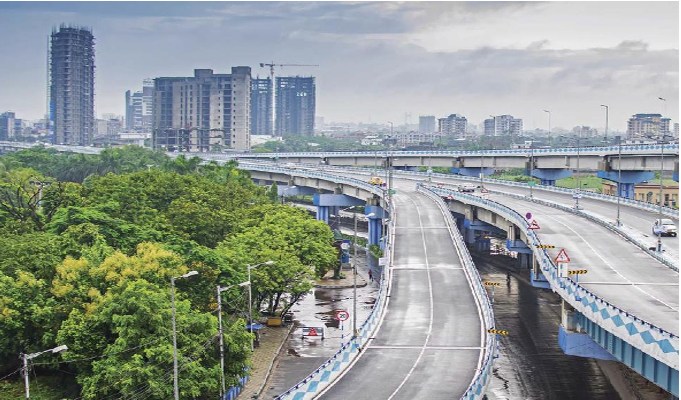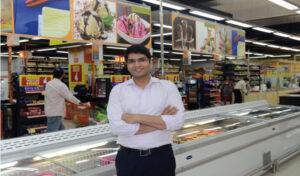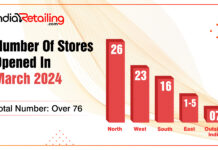Smoothly riding the crest of Eastern India’s aspiration wave and changing shopping trends in the metros, Tier II and III cities of the region have driven the conventional trader-run stores to morph into more organized, large-format retail outlets. And, to facilitate this growth of retail, many retail realty projects have sprung up in all major markets of East India.
As we move further into 2017, most of the Eastern states of India display a glorious upward trend, one which is rapidly reaching skyward. Luxury buying has transmogrified from an occasional indulgence into necessity and increasing consumer spending power is aiding this metamorphosis. The end result – the Great Indian Middle Class has been elevated to a higher level. What was unthinkable in the Eastern region till a few years ago is becoming a reality, thanks to premium retail destinations like Quest Mall, which has opened the luxury retail gateway in Eastern region. It’s because of such premium destinations that customers belonging to a diverse milieu are making a beeline for malls to look at, touch, feel, buy, and then revel in the experience of possessing highend international and national products.
Eastern India is in the cusp of being transformed from a traditional customer base into a fashion conscious, brand-savvy market. Its young generation is shopping and demanding both fashion and quality along with value for money spent from retailers. To meet these impossible demands retailers – big and small, branded and unbranded, regional, national and even international – are gearing up hugely, and very successfully. To cater to these consumers, retailers need to wake up to the importance of managing retailing efficiently and effectively. Retail management saves time and ensures the customers easily locate their desired merchandise and return home feeling satisfied that they have received what they have paid for. The consumers’ ambitions to reach global standards in lifestyle, coupled with high disposable incomes, are aggressively scripting a radical change in the business viability of organised retailing East India.
“East is called the retail market of tomorrow with all its potential. The east Indian economy has grown by about nine per cent annually over the last three years and even higher growth rates are being projected for the future. Malls and large size department stores have become a fixture in the urban landscape across the East Indian countries” says, Regional Marketing Manager, East and Central India, Max Retail Division, Anirban Kundu.
India’s retail market value will reach an estimated Rs 6,156,333 crore (US $1026.06 billion) in 2017. And if this number has to be pushed further then the focus needs to shift from traditional
North and West zones to states like West Bengal, Bihar, Orissa, Jharkhand, Chhattisgarh and the North-eastern states. Retail stalwarts are of the opinion that the true demographic dividend of India would remain untapped if the eastern region is not explored. As the retailers are now looking for scale, sustainability and growth, Eastern India – with format retail players who are present across multiple categories – is the next obvious bet. Be it Pantaloons or Big Bazaar, or regional fashion and lifestyle brands such as Turtle, GKB Lens, Spencer’s or Manyavar, the East has been a major market contributing significantly to overall growth for all these brands.
In this special feature, we speak to the stakeholders of modern retail in the region. We gain their perspective and analyse ‘what the future holds for East India’s retail market’.
1Shashwat Goenka, Sector Head, Spencer’s Retail Ltd
Are you satisfied with the way the organized retail industry has grown in East India until now? How do you see its progress over the last ten years?
India’s retail market is currently valued at US $700 billion and is expected to nearly double by 2020. While the overall retail market is expected to grow at 12 per cent per annum, modern trade would expand twice as fast at 20 per cent per annum and traditional trade at 10 per cent. The industry and Government’s increased focus on West Bengal, Bihar, Orissa, Jharkhand, Chhattisgarh and the North-eastern states will further push these growth figures. From an infrastructure perspective, East India has been well-integrated through improved communication systems, real estate development, urbanization, a well-traveled population and the growing service
sector. There has been a palpable shift in the customer buying pattern and expectations in the East, owing to the increasing middleclass segment, rising disposable incomes and growing aspirations for improved living standard. Th ese factors are further influenced by media exposure, globalization of cultures, lifestyles and better technology. Overall, the East has done a good job in growing the retail industry, and continues to foster retailers – big and small.
How according to you will the modern retail industry evolve in the next 10 years?
The next decade will see further consolidation in the industry and maturity of the Omnichannel model to build a sustainable retail practice. Consumer expectations are high. They want on-demand access to products and services on multiple platforms. It’s not about online and offline, it’s about being seamless across channels. Retail will become more consumer-pull driven and less retailer-push oriented. This approach will bring about a shift in how consumers plan their shopping, consumer journey and purchasing decisions. Retailers will be focusing on making this multi-channel shopping experience seamless and building an engaged customer base. Physical and digital retail will merge into a new avatar, with growth coming from more from Tier II and Tier III cities and towns. Looking ahead to 2026, curated shopping and digital assistants will be widely used. Consumers will soon let a trusted digital assistant like a Chatbot wade through incoming information to identify relevant deals. Consumers will expect convenience and personalization in their interactions with retailers, and brands will accept that this is enabled by sharing personal data. Technology will further merge into the retail space, with retailers already starting to experiment with augmented reality, wearable devices, virtual reality and artifi cial intelligence.
What do you think are the biggest problems and challenges facing the modern retail industry in Eastern India? What bottlenecks must be overcome to allow the industry to grow to its maximum potential?
There are no challenges that are specific to the East only – all of the challenges are applicable across the country. The retail industry as a whole has a few challenges – be it the lack of adequate skilled retail manpower, high attrition, insufficient infrastructure (eg: cold storage facilities) – but they have started to become less concerning due to focus given by the Government. Overall, it is much easier to work in the Eastern part of the country.
What do you think should be done by the industry and the Government to boost the growth of the modern retail sector in East India?
As retailers are looking for scale, Eastern India with its huge population base and market potential provides a plethora of opportunities. Until a few years ago, many retail brands seemed hesitant to step in this market, today they are vying to build presence here. This has been made possible by the joint working of the industry and the Government, facilitating the building of marketing channels and a quality supplier base.
2Manish Agarwal, CEO East, Future Group
Are you satisfied with the way the organized retail industry has grown in East India until now? How do you see its progress over the last ten years?
The progress of organised retail in eastern India has been quite encouraging. Future Group has always believed in the potential of East India. For us everything started from Kolkata. Our focus and spread has been quite large in the states and cities of East India. From Bengal, Bihar, Orissa, Jharkhand, North East and North Bengal, from plains to the hills, we have been quite aggressive in increasing footprints in the eastern part of the country. For the last few years, we feel that many more retail brands have realized the potential of the east and have started venturing in this part. Further, an increase in modern retail is generating a lot of employment opportunity for young Indians, women, and even senior citizens and differently-abled people. This has been quite encouraging and satisfying, to say the least.
How, according to you, will the modern retail industry evolve in the next 10 years?
The journey of modern retail over the next 10 years will be quite interesting. We feel the incubation period seems to be coming to an end and it is now time to explode rapidly. An increase in the younger population, the propensity for higher consumption, willingness to experience new products and services is making the modern retail space very exciting. Aspirations and consumption is not only limited to big cities like Kolkata, Bhubaneshwar, Guwahati, Ranchi, and Patna, but is expanding rapidly in smaller cities and towns of all states in eastern India. Our focus has been equally strong in small cities of the east. There is so much of opportunity to create new retail formats, create new products, build new services and create more jobs. It is upon modern retailers now to grab this opportunity and work towards building a new India.
What do you think are the biggest problems and challenges facing the modern retail industry in Eastern India? What bottlenecks must be overcome to allow the industry to grow to its maximum potential?
Modern retail needs modern spaces to set up retail stores. Quality retail spaces are far too less and demand in the market is far too high. The development of high-street and malls has been slow. Due to constraint of proper retail spaces, affordability of retail spaces has also been a concern for setting up retail stores. There is a need to build infrastructure for modern retail spaces and also incentivize the creators of modern retail spaces and modern retailers. Old laws need to be relooked at to make them more relevant for business today. Having said this we must mention that opportunity is large and it is time that modern retailers and Government should work hand in hand to look at every aspect and work towards making this happen. Every challenge leads to an opportunity for progress and growth, hence it is time to be optimistic.
In which areas do you think the modern retail industry is lagging behind in the East? Where do you think industry has fallen short in the region?
Honestly, I don’t think modern retail industry has lagged behind in East India. It is only that East Indian cities had far too relied on the high-street for retail business. Development of modern retail malls has been less and also modern retail brands have focused late in the east. Future Group has started every venture from Kolkata and East India since 1997 and we have always been bullish and confident on the potential of East India. I would like to quote Kishore Biyani here who always says that ‘Kolkata is my Karmabhumi’.
What do you think should be done by the industry and the Government to boost the growth of the modern retail sector in East India?
RAI who represents retailers has been actively working with the Government on various initiatives to improve the modern retail sector across the nation. Collaborative approach is the way forward. build new malls, simplify laws, create more jobs, build more consumption and participate in nation building is the theme today for every industry.
3Anirban Kundu, Regional Marketing Manager East and Central India, Max Retail Division
Are you satisfied with the way the organized retail industry has grown in East India until now? How do you see its progress over the last ten years?
Well, it’s not at all about satisfaction rather how progress is happening and how you are been able to justify a crucial role in creating and establishing the overall impact of the retail scenario. Being a part of the retail brand, a retail group I personally fell that, the potential in Indian market actually takes the entire country to this level where it is now. Its again not about organized or unorganized retail industry rather the overall potential which lead to a bright future in overall retail industry. The reasons are so many, the Indian retail industry is one of the fastest growing in the world compare to other country. Retail industry in India is expected to grow to US $1.3 trillion by 2020, registering a Compound Annual Growth Rate (CAGR) of 16.7 per cent over 2015-20 which is huge. India is the fifth largest preferred retail destination globally if you check and go by data instead of being there within most adverse markets all around. The country is among the highest in the world in terms of per capita retail store availability. India’s retail sector is experiencing exponential growth, with retail development taking place not just in major cities and metros, but also in Tier-II and Tier-III cities.
How according to you will the modern retail industry evolve in the next 10 years?
As I said retail has a big prospect in terms of exploring business in next coming days from different aspects. Its obvious and as per customer expectation from overall convenience factor, Online retail business is the next generation format which has high potential for growth in the near future. After conquering physical stores, retailers are now foraying into the domain of e-retailing. Even we are also in the same domain with MaxFashion.com. Idea is to create a sink between offline and online store. The readiness and convenience customers are getting from offline store will be provided via online path also and that’s how creating this omniflow connectivity. Almost all retailers are on same path and creating next level of customer experience, coming out of the monopoly word called customer service. That’s the next level, that’s the new consequences for a customer to look retail in a different way. Be it mall, be it brand, be it any form of retail, this application can be applied anywhere and it actually explores different aura altogether. E-commerce is expected to be the next major area supporting retail growth in India.
What do you think are the biggest problems and challenges facing the modern retail industry in Eastern India? What bottlenecks have to be overcome to allow the industry to grow to its maximum potential?
Challenges are so many and if I go by end to end it cover up more areas but I feel these are the main issues which create the basic problems and challenges. To overcome, I personally suggest and highlight few areas which I feel in east has to be given more focus. Retailing as an industry in East India has still a long way to go since it has the maximum potetntial being the most diversified region from each and every angle. To become a truly flourishing industry, retailing needs to overcome the bottlenecks of – regulations restricting real estate purchases and cumbersome local laws, taxation, which favours small retail businesses till now, though with advent of GST we are expecting this issue will be overcomed, absence of developed supply chain and integrated IT management, lack of trained work force, low skill level for retailing management, intrinsic complexity of retailing – rapid price changes, constant threat of product obsolescence and low margins.
In which areas do you think the modern retail industry is lagging behind in the East? Where do you think industry has fallen short in the region?
East is called the retail market for tomorrow with its so much of potential. The east Indian economy has grown by about nine per cent annually over the last three years and even higher growth rates are being projected in the future. Malls and large size department stores have become a fixture in the urban landscape across the east Indian countries. The importance of managing retailing efficiently and effectively is obvious in the light of this sector’s growth potential and the increasing levels of competition. The emergence of organized retailing has given rise to the need for a whole new set of business skills and competencies required to efficiently manage organized retail operations. In addition, it has posed tremendous challenges to existing producers of goods and services – they now need to revisit their distribution policies and distribution relationship management strategies with trained manpower who can guide consumers not as a sales guy but as a fashion consultant. Among many issues we have here, value of assortment, purchase experience, logistics and supply chain issues, financing options, channel consolidation, volume driven relationships and people strategies have acquired completely new dimensions and these are the areas where we really need to work upon and explore new opportunities. Even otherwise, since shopping is all-pervasive retailing is important, both economically and socially, since it affects a large populace in the form of consumers and employers. These all actually create the fallen short areas which we really need to overcome to create the growth in east.
What do you think should be done by the industry and the Government to boost the growth of the modern retail sector in East India?
That’s an interesting part which is completely based out of expectation and assurance, though since the inception stage of retail in east, till now, Government has done so many things to boost the retail sector in east specifically. Government policy with regard to development of retail industry has been liberal and motivating in all circumstances. The traders/ retailers register their outlets/shops with concerned authorities in various cities in east and by honoring sales tax and other obligations of the state concerned, they can run their retail business very easily. With that, till now, there is no constraint on the entry of any domestic business house into retail sector. Governments need to constantly question whether there is a better or more efficient way of achieving objectives. Improving efficiency can involve reducing the costs of production for each unit of output produced but, equally, might be achieved by better matching the supply of goods and services to those things people want most or by removing barriers to innovation and flexibility.
4Sagar J Daryani, Founder, Wow Momo Food Ltd
Are you satisfied with the way the organized retail industry has grown in East India until now? How do you see its progress over the last ten years?
The advent of mall culture and coming of organised brands has helped the modern retail sector grow in East India. Food as a sector has grown really well in Eastern region, Kolkata, Siliguri, Bhubaneshwar, Patna and Northeast markets. We plan to open 20 outlets in Siliguri and Bhubaneshwar combined by the end of this year, taking our store count to 130.
How according to you will the modern retail industry evolve in the next 10 years?
East India is the most commercially viable and potential market for retail. There is lot of scope for growth in Eastern regions. There are various significant markets, which are still virgin but promise a lot of opportunities. Other regions like North, South or West have grown to their optimum level and are now saturated but Eastern India is the land of opportunity and is full of potential. A lot of national/ international brands have already forayed into the region and with the coming of good retail realty projects, the prospects for the region are really bright.
What do you think are the biggest problems and challenges facing the modern retail industry in Eastern India? What bottlenecks must be overcome to allow the industry to grow to its maximum potential?
When we started our business, people in East couldn’t visualise a brand that exclusively sold ‘Momos’, so we didn’t get space in malls and east India has paucity of good high-streets – something which they need to desperately work on. Despite being an Eastern brand, we got acceptance in South India. When we opened our first outlet in Phoenix Marketcity, Bengaluru, we became famous and started being accepted all over the country and even in Kolkata and later in other parts of east India. I feel that the east needs to be more accepting and receptive towards indigenous and innovative retail players.
What do you think should be done by the industry and the Government to boost the growth of the modern retail sector in East India?
The Government can do a lot better than what it has been doing. Licensing needs to be eased. The retail sector needs industry status, not only in east but all over India.
5Sarat Binani, Director, Himalaya Optical
Are you satisfied with the way the organized retail industry has grown in east India until now? How do you see its progress over the last ten years?
Well, there has been good growth in terms of consumer’s purchasing power is concerned when we talk about east India especially West Bengal, which is predominantly the biggest money generator in eastern part of India. In fact, there has been satisfactory growth in terms of consumer purchasing power – primarily due to increase in the penetration of branded stores, and the retail business turning from unorganized to organized. Luxury buying is also showing a marginal improvement. There has also been substantial increase in the buying power of the new middle class. The business is predominantly dependent on middle class. Other states in eastern India like Orissa, Bihar, Jharkhand, North East and suburbs of Bengal are growing rapidly.
Organized retail penetration has increased drastically in the last three years. Keeping in mind the prevailing market dynamics, we expect to see positive growth in the coming years.
How, according to you, will the modern retail industry evolve in the next 10 years?
In the next few years the key influencing factors which would evolve would be – consumer behaviour, shift from unorganized to organized retailing, technological advancements in the retail sector, and mobility.
Consumers now research more; they are more learned and empowered. They have data at their fingertips and hence are more price aware and brand aware. Hence, retailers will have to strive hard to offer its consumer uniqueness in in-store experience. To give consumers a better experience customization and personalisation will become important. Omnichannel retailing will be the need of the era. Delivering an Omnichannel customer experience will become a key brand differentiator for retailers who want to drive increased loyalty and satisfaction among consumers. More and more retailers are trying to make Omnichannel customer engagement a priority.
In the race to give a better experience to its consumers retailers will need to adopt technology. Retailers would continue to invest in apps, social media driven consumption, virtual reality and much more. Today all conventional media like print ads, television, radios, cameras, and computers have all converged into a single instrument – a smartphone. Due to the introduction of 4G, digitalization and cashless transactions will be great influencers and hence mobility will play a very important role in retailing.
India is set to experience a dynamic transformation in the ongoing retail boom that has struck a chord with Indian citizens, particularly the youth! On the transforming Indian retail market that is catching up the pulse of youth on all kinds of digital
platform along with a strong focus on the Indian consumers, importance needs to be given to technology as well as offering quality services.
What do you think are the biggest problems and challenges facing the modern retail industry in Eastern India? What bottlenecks must be overcome to allow the industry to grow to its maximum potential?
Reviewing current social and cultural trends, the biggest challenge is to introduce and assimilate the right technology into our daily operations, with the objective of increasing customer satisfaction. In a market like India, personal relationships are very important; however, certain technologies and digital services irrefutably assist in creating a frictionless customer experience, when these customers shift between channels. Thus, the challenge is to find the right mix of personal touch and technological offerings to ensure the highest level of customer satisfaction attainable.
In which areas is modern retail lagging behind in the East? Where do you think the industry has fallen short in the region?
Innovation is the key to success for any retail brand in the world. According to me innovation and speedily getting adapted to newer business model is one of the biggest lagging in this part of the India. The consumer mindset and the entrepreneur mindset both needs to change faster than the pace we are currently in. Adaptation of technology, understanding the disruptive business models and bringing in new changes accordingly is something which we need to be faster at.
What do you think should be done by the industry and the Government to boost the growth of the modern retail sector in east India?
West Bengal, being the biggest money spinner in eastern India, especially in terms of corporate houses or business houses putting up substantial money into building up industries in West Bengal, the objective of achieving a desirable and substantial growth will not be possible. Moreover, young adults who are our future TG are migrating outside east either out of the country or to other states which is a concern for this part of our country. However, we are still hopeful of this turnaround taking place in future with the Government taking up corrective measures in respect to improve the image of West Bengal in the eyes of industrial giants.













